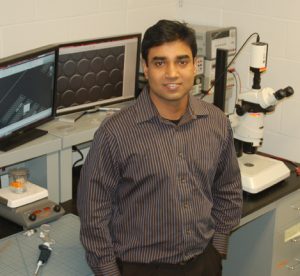
Ames, Iowa — When neuroscientists grow live cells today, they place a petri dish of cells in a temperature- and gas-controlled incubator and hope the cells grow without problems. They can observe the cells only by removing them from the incubator and placing them under a light or electron microscope.
Santosh Pandey, an assistant professor of electrical and computer engineering at Iowa State University, is working to give neuroscientists the first-ever tool that allows them to observe live cells—down to a single neuron—without the aid of a microscope and at real time as the cells grow. Pandey’s tool is a flexible platform that can perform high-resolution sensing of surface charges and ionic currents of living cells. These two measurements provide important information about cell membranes and underlying membrane proteins (aka ion-channels), which could lead to a greater understanding of diseases related to dysfunctions in ion-channels such as Alzheimer’s, epilepsy, cystic fibrosis, migraines, cardiac arrhythmias, and hypertension.
“Understanding the pivotal role of ion-channels and their encoding genes in diagnostics requires measurement tools with high-resolution and distributed sensing,” Pandey said in his research proposal. “This project is motivated by the need to miniaturize arrays of devices with higher resolution and the present lack of integrated measurement tools for advanced cellular studies.”
The tool Pandey is currently developing is a 2 mm x 2 mm silicon chip (about the size of a pinhead) that will house hundreds of thousands of super tiny devices called floating-gate field-effect transistors (FETs) that act as electronic charge sensors. Each of the FETs will be 1 micron in size—roughly the size of a very small dust particle, and 100 times smaller than the diameter of an average strand of human hair.
“Currently, there is no technology to observe continuous growth of live cells at real time,” Pandey said. “The silicon chip we’re creating will have hundreds and thousands of devices, and each device will be capable of remotely monitoring spatial and temporal changes during cell growth.”
The FET devices would be able to detect miniscule fluctuations in the electrical charge of the cell membrane, thus allowing electrophysiologists, molecular biologists and neuroscientists to observe at real time and with high resolution the evolution of surface and ionic charges, as well as electronic cell-to-cell communication, which is an important aspect of a properly functioning nervous system.
“We are focusing on neuronal cell lines and neural networks to study how, when and why they form connections (or synapses), and how these connections are disrupted in the presence of external factors,” Pandey said. “The understanding of neuronal growth and evolution of neural networks on a high-resolution electronic imaging platform will help speed the process of new drug discovery for neurodegenerative diseases.”
The composition of Pandey’s FET device, which includes an integrated system of various charge sensors, sites for accessing the cell membrane and instrumentation amplifiers to process the recorded signals, will allow each neuron growing on the device to be imaged by at least 16 different devices. He said areas such as neuroscience and pharmacology can benefit from his high-throughput, miniaturized platform because it can help them screen compounds faster.
“Pharmaceutical companies working on developing new drugs for dysfunctions of the nervous system could use this in vitro testing platform for real-time observation of drugs on neuronal networks. Such high-throughput bioassays will ultimately help speed medical research in pharmacology and ion-channel diseases,” Pandey said.
According to Pandey, the ultimate goal of his research is to create technology that some day can make brain-on-a-chip (a ‘neural’ computer that performs like the brain but on a much smaller scale) or a brain-computer interface (technology that could assist, augment or repair human cognitive or sensory-motor functions) a reality.
Pandey’s research is supported by a National Science Foundation grant and Richard Martin, a professor of biomedical sciences at Iowa State, is a co-principal investigator on this project.
-30-
Contacts:
Dana McCullough, communications specialist, (262) 264-7810, schmidtd@iastate.edu
Santosh Pandey, assistant professor, (515) 294-7504, pandey@iastate.edu